| Tweet | Follow @OphirGottlieb |  |  |


GTAT is trading $17.00, up 1.7% with IV30™ up 8.6%. The Symbol Summary is included below.
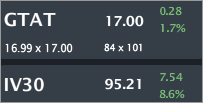
Provided by Livevol
-------
UPDATE: 9-9-2014
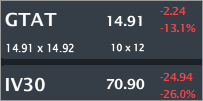
Provided by Livevol
On the heels of AAPL's big day, GTAT is plunging and the risk is deflating.... Is the investment in R&D going to work?
-------
GT Advanced Technologies Inc., a technology company, provides materials and equipment for the solar, light emitting diode (LED), and electronics industries worldwide.
Conclusion
This is a stock and volatility note on a fascinating firm that has seen revenue collapse, earnings collapse and its stock price collapse, then stock explode back up while at the same time standing strong in the face of it all by pouring $0.25 of every dollar spent in operating expense into research & development. The option market is pricing in elevated risk, and there's good reason. This stock may be ready to move.
Let's start with the five-year stock chart.

Provided by Yahoo! Finance
We can see the stock rise from ~$5 to $16, then collapse back to $3, and now run all the way back up to $17. Absolutely incredible. There's a reason for all of that equity dis-equilibrium, so let's look at some financial trends, then turn to risk pricing in the option market.
Revenue
This is the first of three very ugly charts. Whether the firm is on the verge of a break through technology or partnership, as of right now, revenue has imploded from an annual rate of ~$1B to now below $200M.
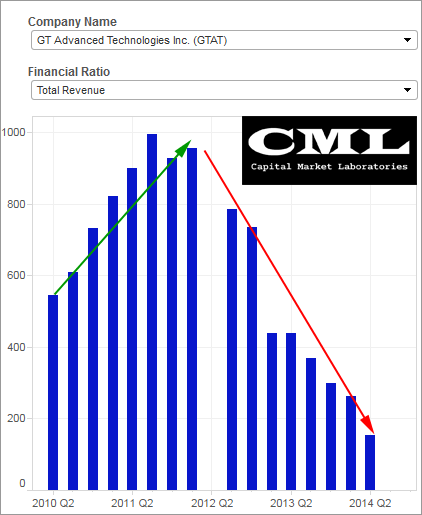
Operating Revenue/Operating Expense
I love this measure because of its great simplicity. At some point, for a firm to make money, this ratio must be greater than 1.0 (at least). We can see that for a while, GTAT had a very nice 1.5:1 ratio of operating revenue to operating expenses, which said differently means the firm paid $0.67 to earn $1 in revenue.
However, this ratio has imploded, and the firm is now paying $2.50 for every dollar in revenue.
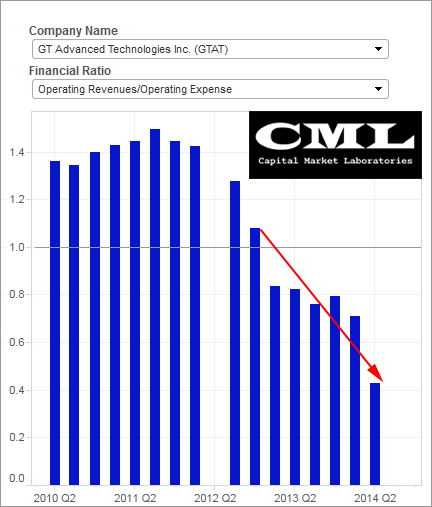
Net Income
The necessarily result of the prior three charts is the earnings chart below. GTAT went from an annual profit of over $200M to now an annual loss of the same amount..
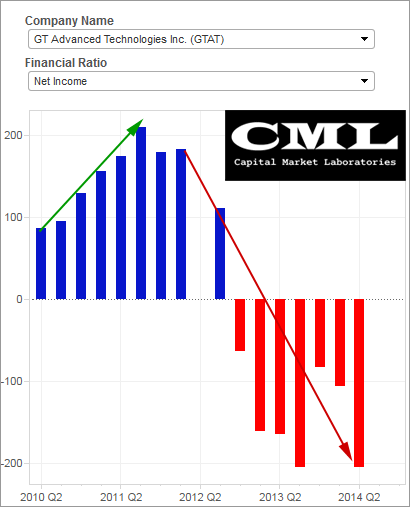
So is all hope lost?... No, not at all...
Research & Development Expense / Operating Expense
The firm has gone from spending ~$0.03 in R&D for every dollar spent to run the company, to now ~$0.28 per dollar. As I said at the top of the article, the firm, standing in the face of pretty miserable financial measure declines, has stood strong and continued to pour money into R&D.
If you're looking for a reason for a 400% stock rise, this is likely it.
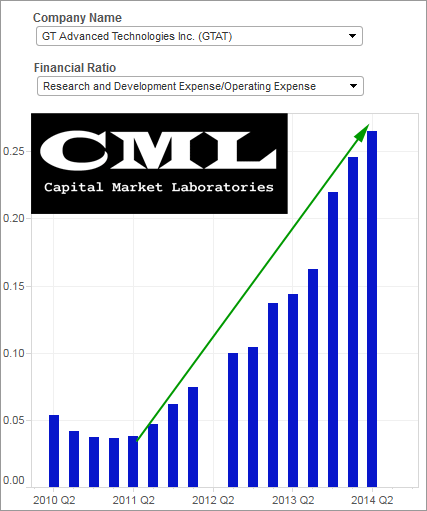
Is there a correlation to this R&D spending to stock price?... Actually, yes, there is:
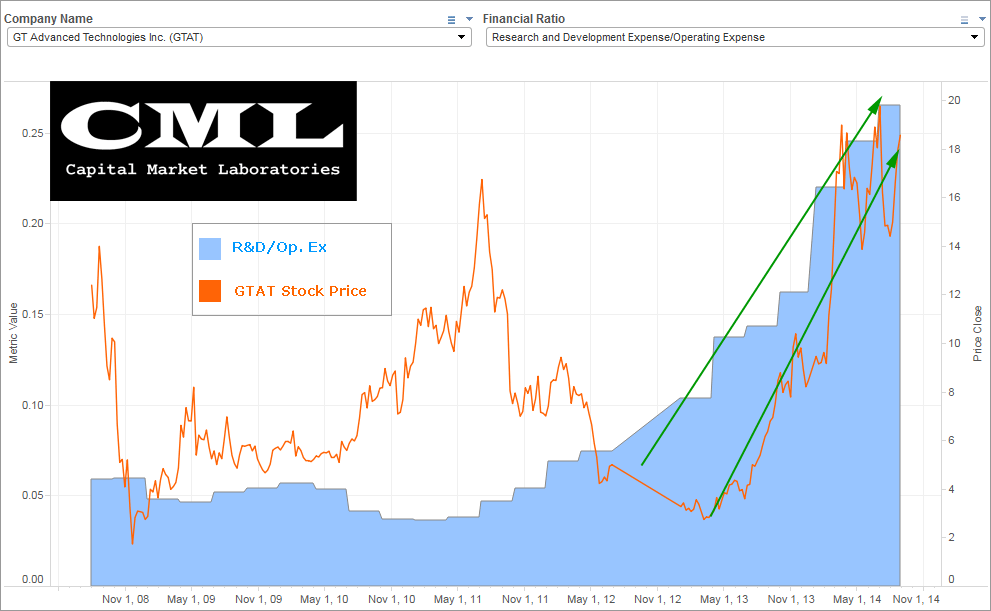
All of these crazy financial measure changes point to risk... and that risk is exploding in the option market. Let's turn to the IV30™ chart in isolation, below.
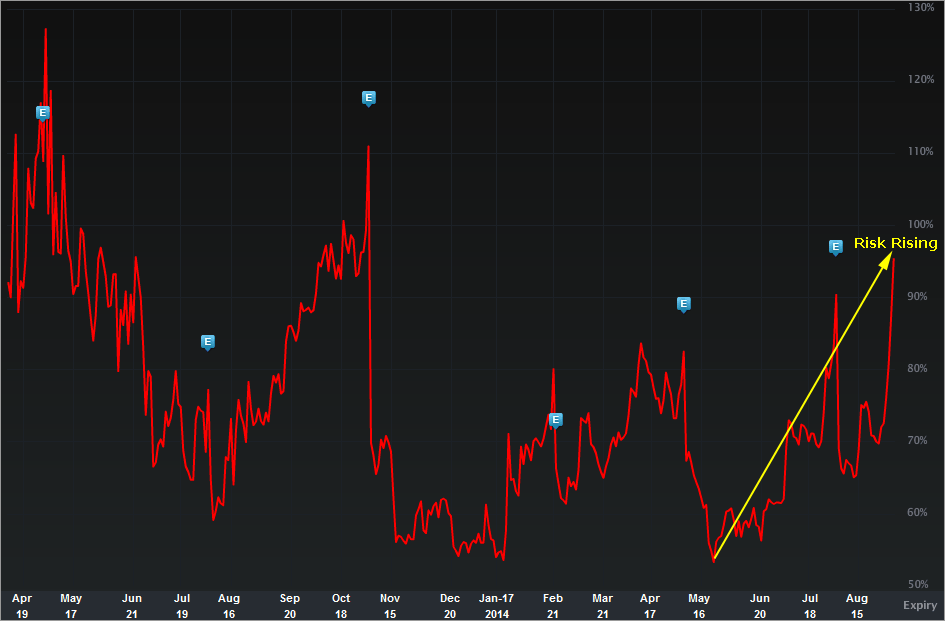
Provided by Livevol
The implied volatility is the forward looking risk in the equity price as reflected by the option market (IV30™ looks forward exactly 30 calendar days).
In English, the red curve is the risk in future stock price movement. We can see the explosion in that red curve since May. The 'risk' has gone from ~55% to now over 95%, while the stock has peaked, bottomed, then peaked again.
Finally, the Options Tab is included below. Here we can see the explicit risk pricing in GTAT.
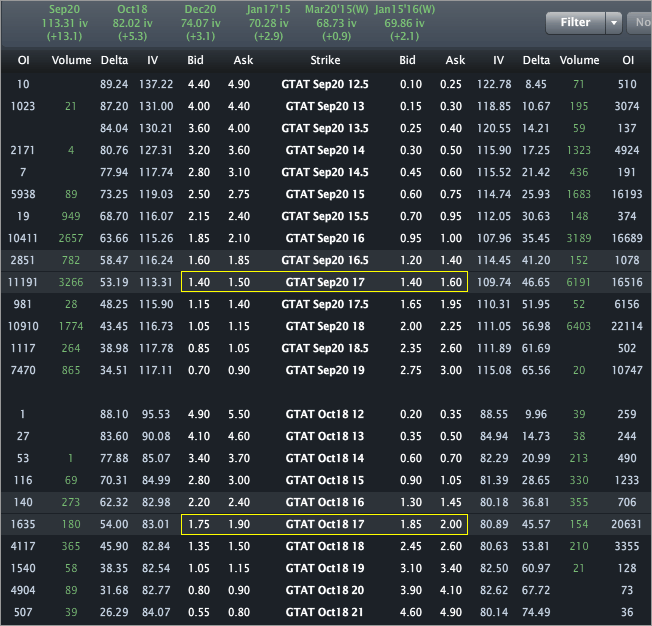
Provided by Livevol
Using the at-the-money (ATM) straddle we can see that the option market reflects a price range of [$14, $20] by the end of trading on Sep 19th.
We can see a price range of [$13.30, $20.70] by the end of trading on Oct 17th.
- If you believe the stock will be outside that range on expiry or any date before then, then you think the volatility is too low.
- If you believe that range is too wide, and that the stock will definitively be in that range on expiration, then you think volatility is too high.
- If you're not sure, and can make an argument for either case, then you think volatility is priced just about right.
This is trade analysis, not a recommendation.
Follow @OphirGottlieb
Tweet
Legal Stuff:
Options involve risk. Prior to buying or selling an option, an investor must receive a copy of Characteristics and Risks of Standardized Options. Investors need a broker to trade options, and must meet suitability requirements.
The information contained on this site is provided for general informational purposes, as a convenience to the readers. The materials are not a substitute for obtaining professional advice from a qualified person, firm or corporation. Consult the appropriate professional advisor for more complete and current information. I am not engaged in rendering any legal or professional services by placing these general informational materials on this website.
I specifically disclaim any liability, whether based in contract, tort, strict liability or otherwise, for any direct, indirect, incidental, consequential, or special damages arising out of or in any way connected with access to or use of the site, even if I have been advised of the possibility of such damages, including liability in connection with mistakes or omissions in, or delays in transmission of, information to or from the user, interruptions in telecommunications connections to the site or viruses.
I make no representations or warranties about the accuracy or completeness of the information contained on this website. Any links provided to other server sites are offered as a matter of convenience and in no way are meant to imply that I endorse, sponsor, promote or am affiliated with the owners of or participants in those sites, or endorse any information contained on those sites, unless expressly stated.


No comments:
Post a Comment